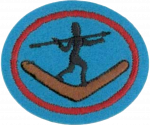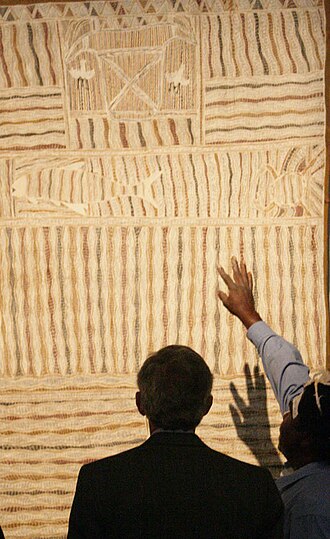Especialidades JA/Tradición aborigen/Respuestas
| Folclore de Aborígenes Australianos | ||
|---|---|---|
| División del Pacífico Sur
|
Destreza: 1 Año de introducción: Desconocido |
|
Requisitos
1. ¿Quiénes son los aborígenes y de dónde han venido? ¿Cuántas tribus había allí cuando comenzó la colonización europea?
2. Discutir el sistema tribal. ¿Qué son los tótems?
3. Discutir el alimento de los aborígenes:
a. Clases
b. ¿Cómo lo obtienen?
c. ¿Cómo lo preparan?
4. Discutir acerca de sus viviendas. ¿De qué son hechas? ¿Por qué no son permanentes?�� ¿Dónde duermen los jóvenes y niños?
5. ¿Cómo se comunican con otras tribus que no puede entender su idioma? ¿Cómo envían señales dentro de la tribu? ¿Cuál es el propósito de la Tjuringa (o Churinga)?
6. ¿Cuáles son algunos de los artículos de comercio e intercambio? ¿Qué utensilios domésticos utilizan ellos?
7. Describir algunas de las armas utilizadas en la caza y la guerra.�
8. ¿Qué es un corroboree? Explicar su propósito. ¿Qué son palos de aplaudir y el diyiridú?
Corroboree is a generic word to explain different genres of performance which in the northwest of Australia include balga, wangga, lirrga, junba, ilma and many more. Throughout Australia the word corroboree embraces songs, dances, rallies and meetings of various kinds. In the past a corroboree has been inclusive of sporting events and other forms of skill display. It is an appropriated English word that has been reappropriated to explain a practice that is different to ceremony and more widely inclusive than theatre or opera.
Clap sticks and the didgeridoo
Aboriginal people developed unique instruments and folk styles. The didgeridoo is commonly considered the national instrument of Aboriginal people, and it is claimed to be the world's oldest wind instrument. However, it was traditionally only played by Arnhem Land people, such as the Yolngu, and then only by the men. It has possibly been used by the people of the Kakadu region for 1500 years. Clap sticks are probably the more ubiquitous musical instrument, especially because they help maintain the rhythm for the song.
9. What games do children play? How are young men trained? How are they initiated? What is the bora ground? What is a bull roarer?
Games
Marn Grook (also spelt marngrook), literally meaning "Game ball", is the collective name given to a number of traditional Indigenous Australian ball games believed to have been played at gatherings and celebrations of up to 50 players.
10. Discuss the two main types of Aboriginal art.
There are many "types" of Aboriginal art, but the two most famous types appear to be bark painting and rock art.
Bark Painting
Bark painting is an Australian Aboriginal art-form which is done on the interior strip of a tree bark. Traditionally, bark paintings were produced for instructional and ceremonial purposes and were transient objects. Today, they are keenly sought after by collectors and public arts institutions.
11. Briefly relate the history of the Aborigines since the white man arrived in Australia, mentioning the government policies through the years and the work of missions.
1788-1900
In 1770, Lieutenant James Cook claimed the east coast of Australia in the name of Great Britain and named it New South Wales. British colonisation of Australia began in Sydney in 1788. The most immediate consequence of British settlement – within weeks of the first colonists' arrival – was a wave of European epidemic diseases such as chickenpox, smallpox, influenza and measles, which spread in advance of the frontier of settlement. The worst-hit communities were the ones with the greatest population densities, where disease could spread more readily. In the arid centre of the continent, where small communities were spread over a vast area, the population decline was less marked.
Referencias
- Categoría: Tiene imagen de insignia
- Adventist Youth Honors Answer Book/Honors/es
- Adventist Youth Honors Answer Book/es
- Adventist Youth Honors Answer Book/Skill Level 1/es
- Categoría: Libro de respuestas de especialidades JA/Especialidades introducidas en Desconocido
- Adventist Youth Honors Answer Book/South Pacific Division/es
- Adventist Youth Honors Answer Book/Unknown/es
- Adventist Youth Honors Answer Book/Unknown/Primary/es
- Adventist Youth Honors Answer Book/Stage 100/es
- Adventist Youth Honors Answer Book/Completed Honors


